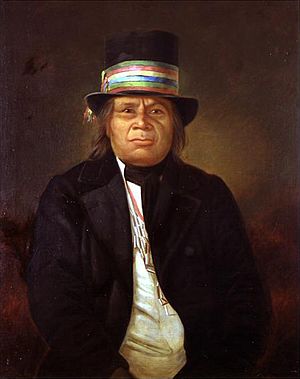Chief Oshkosh facts for kids
Quick facts for kids
Oshkosh
|
|
|---|---|

Portrait by Samuel Marsden Brookes, c. 1858
|
|
| Head Chief of the Menominee | |
| In office August 7, 1827 – August 31, 1858 |
|
| Preceded by | Chawanon |
| Succeeded by | Akwinemi |
| Personal details | |
| Born | 1795 near present-day Nekoosa, Wisconsin, U.S. |
| Died | August 31, 1858 (aged 62–63) Keshena, Wisconsin, U.S. |
| Spouses |
|
| Children |
|
| Profession | Native American chief |
| Military service | |
| Allegiance | British Empire United States |
| Years of service |
|
| Battles/wars | |
Chief Oshkosh (also spelled Os-kosh) was an important leader of the Menominee Native American people. He was born in 1795 and served as their head chief from 1827 until he passed away in 1858.
Chief Oshkosh played a key role in talks with the United States government. These talks were about land in Wisconsin and Michigan. During his time as chief, the Menominee gave up a lot of land to the U.S. government. But Oshkosh worked hard to make sure his people kept some of their ancestral land. He helped secure the 235,524-acre (953.13 km2) Menominee Indian Reservation for his tribe.
The city of Oshkosh, Wisconsin, is named after him.
Contents
Early Life and Family
Oshkosh was born around 1795 near Nekoosa, Wisconsin. His name means "Claw" in the Ojibwe language. His family was part of the Bear Clan. His grandfather, Chawanon, was also a head chief of the Menominee.
During the War of 1812, Oshkosh fought alongside the British. He was part of a group of about 100 Menominee warriors. They were led by Chief Tomah. Oshkosh took part in several battles, including the sieges of Fort Mackinac, Fort Meigs, and Fort Stephenson. He also fought in the 1814 Battle of Mackinac Island.
Becoming Chief of the Menominee
After Chief Chawanon passed away in 1821, there was no clear leader for the Menominee. In 1827, Oshkosh was involved in important discussions with the U.S. government. These talks were about moving other Native American groups, like the Oneida and Stockbridge, onto Menominee land in Wisconsin.
During these talks, U.S. officials noticed the Menominee didn't have one main leader. So, on August 7, 1827, they chose Oshkosh to be the Principal Chief. This made him the main contact person between the Menominee people and the United States government.
Important Treaties and Land Deals
The land disagreements were finally settled in 1832. The Menominee signed the 1831 Treaty of Washington. In this treaty, they gave up 2,500,000 acres (10,000 km2) of land for $125,000. They signed another treaty in 1832, giving up more land for the New York Native American groups. Oshkosh was at the first talks, but his younger brother signed the 1832 treaty for him.
While these talks were happening, the Menominee helped the United States during the Black Hawk War. Oshkosh was part of a group of Native American troops. They patrolled the Mississippi River in July 1832.
In 1836, the U.S. government wanted even more Menominee land. Oshkosh met with Governor Henry Dodge to discuss this. They signed the Treaty of the Cedars. In this treaty, the Menominee gave up 4,000,000 acres (16,000 km2) of land. They received $800,000 and agreed to move to a new area near Lake Poygan.
In 1848, the Treaty of Lake Poygan was signed. Oshkosh gave up the Menominee's remaining lands in Wisconsin. In return, they were offered 600,000 acres (2,400 km2) in Minnesota and $20,000. The treaty allowed the tribe to stay in Wisconsin until 1850.
Oshkosh visited the Minnesota land in 1850. He was not happy with it. There wasn't much game for hunting, and there were conflicts between other tribes there. So, Oshkosh went to Washington D.C. to ask President Millard Fillmore if his tribe could stay in Wisconsin. The President allowed them to stay longer, giving them several extensions.
In 1852, the Menominee were allowed to stay on a temporary reservation along the Wolf River in Wisconsin. Then, in 1854, the Wolf River Treaty made the 250,000-acre (1,000 km2) Menominee Indian Reservation a permanent home for his people. Oshkosh was not happy with this treaty at first, but he signed it after the government offered more money.
In 1856, some other tribes, like the Stockbridge and Munsee, were moved near the Menominee Reservation. Oshkosh and other Menominee leaders signed a treaty. This treaty gave 46,000 acres (190 km2) of the Menominee Reservation to these other tribes. This created a separate reservation for the Stockbridge–Munsee Community.
Personal Life
Chief Oshkosh was married three times. With his first wife, Bambani, he had three sons: Akwinemi, Niopet, and Koshkanoque. He did not have children who survived with his second wife, Shakanouiu. With his third wife, Tomokoum, he had a daughter named Kinoke. He also had an adopted son.
Passing and Burial
Chief Oshkosh passed away in Keshena, Wisconsin, on August 31, 1858. His oldest son, Akwinemi, became the head chief in 1859.
In 1926, Oshkosh's remains were moved to Menominee Park in Oshkosh, Wisconsin. They were buried at the base of a monument built in his honor. However, some people have wondered if the correct remains were moved. There are some who believe his body was never taken from the Menominee reservation.
Images for kids


